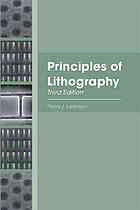Table Of ContentPrinciples of
Lithography
Third Edition
Principles of
Lithography
Third Edition
Harry J. Levinson
Bellingham, Washington USA
LibraryofCongressCataloging-in-PublicationData
Levinson,HarryJ.
Principlesoflithography/HarryJ.Levinson.–3rded.
p.cm.–(Pressmonograph;198)
Includesbibliographicalreferencesandindex.
ISBN978-0-8194-8324-9
1.Integratedcircuits–Designandconstruction.2.Microlithography.I.Title.
TK7874.L3972010
621.3815(cid:48)31–dc22
2010026775
Publishedby
SPIE
P.O.Box10
Bellingham,Washington98227-0010USA
Phone:+1360.676.3290
Fax:+1360.647.1445
Email:[email protected]
Web:http://spie.org
Copyright(cid:13)c 2010SocietyofPhoto-OpticalInstrumentationEngineers
Allrightsreserved.Nopartofthispublicationmaybereproducedordistributedinanyformorbyanymeans
withoutwrittenpermissionofthepublisher.
Thecontentofthisbookreflectstheworkandthoughtoftheauthor(s).Everyefforthasbeenmadetopublish
reliableandaccurateinformationherein,butthepublisherisnotresponsibleforthevalidityoftheinformationor
foranyoutcomesresultingfromreliancethereon.
PrintedintheUnitedStatesofAmerica.
Contents
PrefacetotheThirdEdition........................................................................... ix
PrefacetotheSecondEdition....................................................................... xi
Preface...............................................................................................................xiii
Chapter1 OverviewofLithography................................................................ 1
Problems........................................................................................................................... 6
Chapter2 OpticalPatternFormation.............................................................. 7
2.1 TheProblemofImaging................................................................................ 7
2.2 AerialImages.................................................................................................... 9
2.3 TheContributionsofPhysicsandChemistry......................................... 22
2.4 Focus.................................................................................................................... 32
Problems........................................................................................................................... 46
References....................................................................................................................... 47
Chapter3 Photoresists................................................................................... 51
3.1 PositiveandNegativeResists....................................................................... 51
3.2 AdhesionPromotion....................................................................................... 54
3.3 ResistSpinCoating,Softbake,andHardbake........................................ 57
3.4 PhotochemistryofNovolak/DNQg-andi-lineResists...................... 68
3.5 Acid-CatalyzedDUVResists...................................................................... 70
3.6 DevelopmentandPost-ExposureBakes................................................... 76
3.7 OperationalCharacterization....................................................................... 81
3.8 Line-EdgeRoughness..................................................................................... 82
3.9 MultilayerResistProcesses.......................................................................... 92
Problems........................................................................................................................... 95
References....................................................................................................................... 96
Chapter4 ModelingandThin-FilmEffects.....................................................109
4.1 ModelsofOpticalImaging........................................................................... 109
vi Contents
4.2 Aberrations......................................................................................................... 114
4.3 ModelingPhotochemicalReactions.......................................................... 122
4.4 Thin-FilmOpticalEffects............................................................................. 125
4.5 Post-ExposureBakes...................................................................................... 130
4.6 MethodsforAddressingtheProblemsofReflectiveSubstrates...... 133
4.7 Development...................................................................................................... 140
Problems........................................................................................................................... 141
References....................................................................................................................... 141
Chapter5 WaferSteppers...............................................................................147
5.1 Overview............................................................................................................. 147
5.2 LightSources..................................................................................................... 150
5.3 IlluminationSystems...................................................................................... 162
5.4 ReductionLenses............................................................................................. 166
5.5 AutofocusSystems.......................................................................................... 185
5.6 TheWaferStage............................................................................................... 187
5.7 Scanning.............................................................................................................. 193
5.8 Dual-StageExposureTools.......................................................................... 195
5.9 LithographyExposureToolsbeforeSteppers........................................ 196
Problems........................................................................................................................... 201
References....................................................................................................................... 201
Chapter6 Overlay............................................................................................215
6.1 AlignmentSystems.......................................................................................... 217
6.1.1 Classificationofalignmentsystems.......................................... 221
6.1.2 Optical methods for alignment and wafer-to-reticle
referencing......................................................................................... 221
6.1.3 Numberofalignmentmarks........................................................ 227
6.2 OverlayModels................................................................................................ 228
6.3 Matching............................................................................................................. 237
6.4 Process-DependentOverlayEffects.......................................................... 247
Problems........................................................................................................................... 249
References....................................................................................................................... 250
Chapter7 MasksandReticles.........................................................................257
7.1 Overview............................................................................................................. 257
7.2 MaskBlanks...................................................................................................... 259
7.3 MechanicalOptical-PatternGenerators.................................................... 261
7.4 Electron-BeamLithographyandMaskWriters..................................... 262
7.5 OpticalMaskWriters...................................................................................... 276
7.6 ResistsforMaskMaking............................................................................... 277
7.7 Etching................................................................................................................. 281
7.8 Pellicles............................................................................................................... 281
Contents vii
7.9 Mask-DefectInspectionandRepair.......................................................... 289
Problems........................................................................................................................... 293
References....................................................................................................................... 294
Chapter8 ConfrontingtheDiffractionLimit...................................................307
8.1 Off-AxisIllumination..................................................................................... 307
8.2 OpticalProximityEffects.............................................................................. 316
8.3 TheMask-ErrorFactor................................................................................... 326
8.4 Phase-ShiftingMasks..................................................................................... 330
8.5 PuttingItAllTogether.................................................................................... 341
Problems........................................................................................................................... 343
References....................................................................................................................... 343
Chapter9 Metrology........................................................................................351
9.1 LinewidthMeasurement................................................................................ 351
9.1.1 Linewidth measurement using scanning electron
microscopes....................................................................................... 351
9.1.2 Scatterometry.................................................................................... 359
9.1.3 Electricallinewidthmeasurement.............................................. 361
9.2 MeasurementofOverlay............................................................................... 363
Problems........................................................................................................................... 366
References....................................................................................................................... 367
Chapter10 ImmersionLithographyandtheLimitsofOpticalLithography....371
10.1 ImmersionLithography.................................................................................. 372
10.2 TheDiffractionLimit...................................................................................... 377
10.3 ImprovementsinOptics................................................................................. 380
10.4 MaximumNumericalAperture................................................................... 381
10.5 TheShortestWavelength............................................................................... 384
10.6 ImprovedPhotoresists.................................................................................... 386
10.7 FlatterWafers.................................................................................................... 387
10.8 HowLowCank1 Go?..................................................................................... 388
10.9 HowFarCanOpticalLithographyBeExtended?................................ 389
10.10 DoublePatterning............................................................................................ 395
10.11 InterferometricLithography......................................................................... 400
Problems........................................................................................................................... 401
References....................................................................................................................... 402
Chapter11 LithographyCosts..........................................................................407
11.1 Cost-of-Ownership.......................................................................................... 407
11.1.1 Capitalcosts...................................................................................... 408
11.1.2 Consumables..................................................................................... 416
viii Contents
11.1.3 Maskcosts.......................................................................................... 417
11.1.4 Rework................................................................................................ 419
11.1.5 Metrology........................................................................................... 419
11.1.6 Maintenancecosts........................................................................... 420
11.1.7 Laborcosts......................................................................................... 420
11.1.8 Facilitiescosts................................................................................... 421
11.2 Mix-and-MatchStrategies............................................................................. 421
Problems........................................................................................................................... 423
References....................................................................................................................... 424
Chapter12 ExtremeUltravioletLithography....................................................425
12.1 BackgroundandMultilayerReflectors..................................................... 425
12.2 EUVLithographySystemOverview......................................................... 430
12.3 EUVMasks........................................................................................................ 433
12.4 SourcesandIlluminators............................................................................... 436
12.5 EUVOptics........................................................................................................ 441
12.6 EUVResists....................................................................................................... 443
Problems........................................................................................................................... 448
References....................................................................................................................... 450
Chapter13 AlternativeLithographyTechniques..............................................459
13.1 ProximityX-rayLithography....................................................................... 459
13.2 Electron-BeamDirect-WriteLithography............................................... 465
13.2.1 Single-beamdirect-writesystems.............................................. 469
13.2.2 Multiple-electron-beamdirect-writesystems........................ 470
13.2.3 Cell-projectionlithography.......................................................... 474
13.2.4 Scattering-maskelectron-projectionlithography.................. 474
13.3 Ion-ProjectionLithography.......................................................................... 477
13.4 ImprintLithography........................................................................................ 479
13.5 DirectedSelf-Assembly................................................................................. 480
13.6 TheUltimateFutureofLithography......................................................... 481
Problems........................................................................................................................... 483
References....................................................................................................................... 483
AppendixA:Coherence.................................................................................491
Problems........................................................................................................................... 494
References....................................................................................................................... 494
Index...................................................................................................................495
ColorPlatesSectionfollowspage................................................................256
Preface to the Third Edition
The need to update Principles of Lithography only five years after the release
of the second edition is evidence of the quickly changing and exciting nature of
lithographyasappliedtotheproductionofintegratedcircuitsandothermicro-and
nanoscale devices. Since the second edition was written, immersion lithography
has moved from development into volume manufacturing, double patterning
methods have been developed to maintain scaling using optical lithography,
extreme ultraviolet (EUV) lithography has started to move from the laboratory to
developmentpilotlines,andtherehasbeenasignificantincreaseinskillsinmany
otheraspectsoflithography.Ihopethatthereadersofthisneweditionaresatisfied
with my efforts to explain the salient points of the newly developed technology.
Forstudents,Ihaveaddedmorehomeworkproblems.
As a practical matter, not every contribution to lithography described in a
publication could be referenced, but I do hope that I have properly recognized
the work of others, while providing the reader with a tractable and useful list of
references.
I would like to thank the many people who contributed to this latest
edition of Principles of Lithography, providing figures, papers, and explanations.
Specific figures were provided by Lars Liebmann (10.18), David Kyser of
Applied Materials (Fig. 7.11), Simi George of Lawrence Berkeley Laboratories
(Fig. 12.18), David Brandt of Cymer (Fig. 12.17), Hiroko Takeuchi of Nuflare
(Fig. 7.6), Norihiro Yamamoto of Spansion (Figs. 7.26 and 7.27), Bruno La
FontaineofCymer(Figs.12.1and12.2),StefanWurmofGLOBALFOUNDRIES
(Fig.12.6),WolfgangHolzapfelofHeidenhain(Fig.5.36),AndreasErdmannfrom
the Fraunhofer Institute (Fig. 5.45), Brigette Wehrmann and Leah Rickman of
Suss Microtec (Fig. 5.48), Kafai Lai of IBM (Fig. 8.34), and Paul Nealey from
theUniversityofWisconsin(Fig.13.20).
Robert L. Brainard of the State University of New York (SUNY),
Albany, provided useful information on resists for next-generation lithography.
Conversations with Andrew Hazelton of Nikon regarding linewidth control and
double patterning were also very useful. Christian Buergel and Fritz Gans
of the AMTC supplied information on mask making and inspection. Anna
TchikoulaevaandPaulAckmannofGLOBALFOUNDRIESprovidedconstructive
suggestions to improve the chapter on masks and reticles. Joe Daggett from
Sumika provided useful information on adhesion promotion. Assistance with
EUV transmission calculations from Erik Gulliksen of Lawrence Berkeley
Laboratories was most appreciated. Discussions with Uzodinma Okoroanyanwu
of GLOBALFOUNDRIES were helpful for understanding pinhole formation
in ultrathin resists. Yuansheng Ma, also from GLOBALFOUNDRIES, helped
significantly with the section on resist line-edge roughness. Vito Dai of
GLOBALFOUNDRIES supplied expert advice on data handling for direct-write

